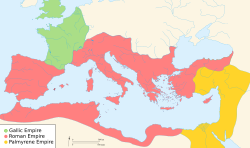Palmyrene Empire
Palmyrene Empire | |||||||||
|---|---|---|---|---|---|---|---|---|---|
| 260–273 | |||||||||
 The Palmyrene Empire (yellow) under Zenobia by AD 271 | |||||||||
| Capital | Palmyra | ||||||||
| Common languages | Latin (official), Greek | ||||||||
| Government | Monarchy | ||||||||
• 260-267 | Septimius Odaenathus | ||||||||
• 267-271 | Zenobia | ||||||||
| Historical era | Late Antiquity | ||||||||
• Established | 260 | ||||||||
• Disestablished | 273 | ||||||||
| |||||||||
The Palmyrene Empire (260–273) was a splinter empire that broke off of the Roman Empire during the Crisis of the Third Century. It encompassed the Roman provinces of Syria, Palestine, Egypt and large parts of Asia Minor.
The Palmyrene Empire was ruled by Queen Zenobia for her infant son Vaballathus. The capital of the short-lived empire was the city of Palmyra.
Crisis of the Third Century
Despite a number of crises, the Roman Empire had stood firm since its inception under Augustus. But after emperor Alexander Severus was murdered by soldiers in 235, Roman legions were defeated in a campaign against Sassanid Persia, and the empire fell apart. General after general squabbled over control of the empire, the frontiers were neglected and subjected to frequent raids by Carpians, Goths, Vandals and Alamanni, and outright attacks from aggressive Sassanids in the east.
Finally, by 258, the attacks were coming from within, when the Empire broke up in to three separate competing states. The Roman provinces of Gaul, Britain and Hispania broke off to form the Gallic Empire.
Since Rome was unable to protect the eastern provinces against the Sassanids, then-governor Septimius Odaenathus decided to use the substantial legions he had at his disposal - among them the famed Legio XII Fulminata - to defend his provinces, rather than intervene in the struggles for Rome.
Establishment of the Empire
Septimius Odaenathus was assassinated and his son Vaballathus was made king (rex consul imperator dux Romanorum, "illustrious King of Kings" and corrector totius orientis) of the Palmyrene Empire.
The real power behind the throne was his mother Zenobia. With the legions at her disposal, and aided by the continuing struggle for Rome, Zenobia conquered Egypt, Syria, Palestine, Asia Minor and Lebanon. She even adopted the title of Augustus for her son and herself.
Reconquest by Aurelian


In 270, Aurelian became Roman emperor. After defeating the Alamanni, who were threatening to invade Italy, Aurelian turned his attention to the lost eastern provinces - the Palmyrene Empire.
Asia Minor was recovered easily; every city but Byzantium and Tyana surrendered to him with little resistance. The fall of Tyana lent itself to a legend; Aurelian to that point had destroyed every city that resisted him, but he spared Tyana after having a vision of the great philosopher Apollonius of Tyana, whom he respected greatly, in a dream. Apollonius implored him, stating: "Aurelian, if you desire to rule, abstain from the blood of the innocent! Aurelian, if you will conquer, be merciful!" Whatever the reason, Aurelian spared Tyana. It paid off; many more cities submitted to him upon seeing that the emperor would not exact revenge upon them.
Aurelian defeated Queen Zenobia in the Battle of Immae and again, decisively, in the Battle of Emesa. Within six months, his armies stood at the gates of Palmyra, which surrendered when Zenobia tried to flee to the Sassanid Empire. The Palmyrene Empire was no more.
After a brief clash with the Persians and another in Egypt against usurper Firmus, Aurelian returned to Palmyra in 273 when it rebelled again. This time, Aurelian allowed his soldiers to sack the city, and Palmyra never recovered from this. He was known as Parthicus Maximus and Restitutor Orientis ("Restorer of the East").
See also
- Gallic Empire
- Rex Winsbury, Zenobia of Palmyra: History, Myth and the Neo-Classical Imagination. Duckworth, September 2010, ISBN 978-0-7156-3853-8
References
- The "Tyranni Triginta", a book of the Augustan History (written in the 4th century) contains an unreliable account of Zenobia's life and triumph.
- This article incorporates text from a publication now in the public domain: Chisholm, Hugh, ed. (1911). Encyclopædia Britannica (11th ed.). Cambridge University Press.
{{cite encyclopedia}}: Missing or empty|title=(help) - Long, Jacqueline, "Vaballathus and Zenobia", De Imperatoribus Romanis site.
